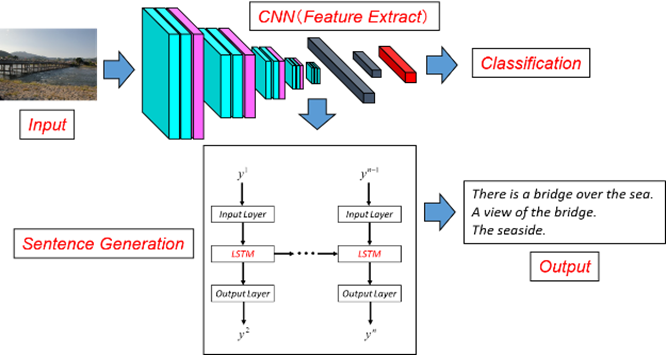Using neural networks (deep learning) and other machine learning techniques, we are developing algorithms for pattern recognition, natural language, data analysis, and cognitive information processing (human vision, language, and sensory information processing). In particular, we are attempting to model human learning mechanisms and devise algorithms for engineering applications on computers.
Seminar In Administration Engineering, Bachelor’s Thesis, Laboratories, In Administration Engineering(3), Programming Languages, Machine Learning, Introduction To Administration Engineering, Introduction To Informatics, Pattern Recogniton and Machine Learning
Image recognition is a pattern recognition technology that detects and analyzes specific objects such as characters and faces from videos and images. Using artificial neural networks and evolutionary computation, we are attempting to develop algorithms for image recognition, image attribute estimation, and automatic image generation.
Natural language processing is a technology that uses computers to process the language (natural language) that humans use. Using machine learning, we are attempting to develop algorithms for reputation analysis, automatic summary generation, and automatic sentence generation.

Fig.1 Pattern Recognition: generating summary sentences for images.

Fig.2 Natural Language Processing: generating summary sentences for news articles.
With the advancement of Internet technology, it is now possible to obtain massive amounts of data. We are investigating the use of neural networks and machine learning to analyze large amounts of data. We analyze a wide range of data, including social network service analysis and weather forecasting.
Cognitive information processing is a research field that models and stimulates human vision, language, and sensitivity on a computer. We are researching the modeling of the human visual cortex in areas, such as visibility, separation of figure and ground (distinguishing objects from background), depth perception, and language acquisition. We are also attempting to apply our findings to real-world problems in pattern recognition, natural language processing, and data analysis.

Fig.3 Data Analysis: Temperature distribution estimation by kriging.

Fig.4 Cognitive Information Processing: Object detection model.
Machine learning and deep learning are gaining popularity as technologies for addressing societal issues, and everyone is learning how to use them effectively through programming. As a result, we hope that students will not only handle these technologies superficially but will also develop new ideas and algorithms based on a solid understanding of them.
Administration engineering is a branch of study that includes “people,” “things,” “finance,” and “information”. Machine learning is a field with a strong emphasis on “information,” but we want students to learn about other fields as well. This is because we believe that students with an advanced knowledge in machine learning and administration engineering will be able to contribute to society.